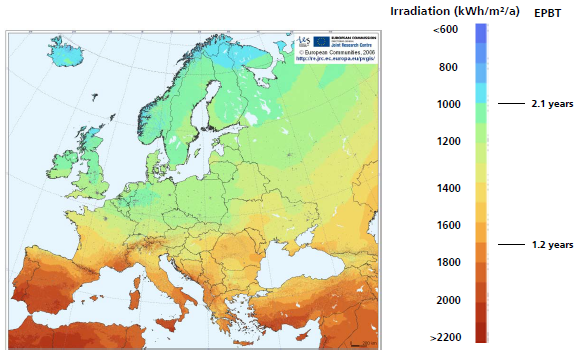With growing concerns about existing toxic energy sources such as coal, petroleum and nuclear and their impact on our environment and health, people are increasingly turning to clean, renewable energy for electrical generation. Solar photovoltaics (PV) produce electricity without the carbon emissions or nuclear radiation associated with traditional energy sources.
But, do solar photovoltaics really ever actually produce enough energy to “pay-back” the energy embedded in the panel? That is, how long before a solar panel/PV system produces enough energy to equal the amount of energy it took to produce it?
Lots of energy is needed to harvest and transport silicon feedstock, manufacture silicon ingot/crystalline wafers, process the cell, manufacture the aluminum frame, glass, backsheets, mounting hardware, wire and the inverter. Once all these materials are built into usable products, they still have to be transported to their installation location. All of these steps use up energy before the solar panel produces a single watt of energy.
Researchers have been monitoring this dynamic over the years and the great news is that solar does payback the energy used to create it – more than twenty times over during its working life of 30-years. Not only that, but because of efficiencies and material reductions, less energy is needed today to get solar to market, so the energy payback period continues to decrease.
Solar PV Energy Payback and Cumulative Energy Production
In 2004, the US National Renewable Energy Laboratory, (NREL) showed rooftop solar panels in the US becoming net-positive within four-years [1] (Figure 1). NREL also showed the cumulative energy produced over 30-years by the solar panel is more than 20 times the energy embedded (Figure 2).


Solar Irradiation Matters
The 2004 NREL study anticipated a further reduction in the energy payback time for multicrystalline and thin-film solar and indeed this occurred as ten years later, in 2014, Germany’s Fraunhofer Institute found energy paybacks in Northern Europe around 2.5-years and in Southern Europe, only 1.5-years or less [2]. The difference in these rates was primarily due to the level of solar insolence where the solar was installed. (The greater the irradiation, the lower the payback period.)
Energy Pay-Back Time of Multicrystalline Silicon PV Rooftop Systems in Europe – Geographical Comparison in 2014

So, the great news is that yes, solar does pay its energy back, many times over and the payback is happening quicker and quicker. Areas with greater solar irradiation have quicker payback periods. Some contributors to the reductions in payback are increased manufacturing efficiencies and thinner silicon wafers.
The even better news is that Washington falls right around the 2.1-year payback period on the irradiation scale shown above.
Solar Has Already Paid Off It’s GHG Debt
Another very interesting and similar concept is thinking about all the solar that has been deployed over the past 40-years across the globe and the greenhouse gases (GHG) that were emitted to manufacture the solar. By some calculations, the so-called “break-even point” between dirty energy input and clean output may already have arrived. Recent studies [3] “show strong downward trends of environmental impact” of solar panel production.
For every doubling in solar capacity installed, energy used to produce solar panels decreased by 12-13%, and greenhouse gas emissions dropped by 17-24%, depending on the material used.
The following charts show 40 years of : a) cost per watt; b) the energy payback period and c) greenhouse gas emissions. All three charts show a downward trend for cost, payback and greenhouse gases!

So, for those of you concerned about the embedded energy payback period and greenhouse gas emissions, solar PV is in great shape and only getting better.
[1] What is the Energy Payback for Solar PV? (2004). National Renewable Energy Laboratory, US Department of Energy. http://www.nrel.gov/docs/fy04osti/35489.pdf.
[2] Photovoltaics Report (2014). Fraunhofer Institute, Germany. https://www.ise.fraunhofer.de/content/dam/ise/de/documents/publications/studies/Photovoltaics-Report.pdf.
[3] Re-assessment of net energy production and greenhouse gas emissions avoidance after 40 years of photovoltaics development. Atse Louwen, Wilfried G. J. H. M. van Sark, André P. C. Faaij & Ruud E. I. Schropp (2012) Nature Communications. https://www.nature.com/articles/ncomms13728.
Last Modified: August 24, 2017

